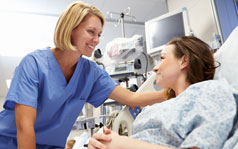Paediatrics
Contact Us
Request an AppointmentPlease note that a referral letter is required before an appointment can be confirmed.
Useful Information
About our services
Paediatric care is delivered by a specialist team including paediatric surgeons and paediatric anaesthetists along with a dedicated team of paediatric qualified nurses and a paediatric co-ordinator.
The paediatric service at Mater Private Network offers medical and surgical treatment for children from the ages of 2 up to 14 years old. The specialties covered include:
- Anaesthesia
- Cardiology: we work with the cardiac team at Crumlin’s Children’s Hospital to perform cardiac ablation procedures.
- Ear, Nose and Throat (ENT): adenotonsillectomy, microscopy of ear, grommet insertion and other minor ENT surgical procedures.
- Ophthalmology: blocked tear ducts, cysts, and ptosis.
- Oral surgery: dental extraction.
- Plastic surgery: otoplasty, cysts, and congenital moles.
- Sleep disorders: narcolepsy, and sleep apnoea.
At Mater Private Network we have a long tradition in care which includes a full time paediatric programme for children from two years. Surgeons and anaesthetists involved in the delivery of this service hold appointments between the Children’s University Hospital, Temple Street and Mater Private Network. Our service has been specifically tailored to the clinical needs of children.
A hospital visit, whether an appointment or a longer stay, can be stressful for both you and your child. If your child knows what is happening it will make it easier.
- Talk about hospital as a cheerful place where doctors and nurses help to make people better.
- Play doctors and nurses.
- Read hospital stories.
- Reassure your child that you will be there as much as possible, and that he or she will be coming home.
- Talk to your doctor or nurse about what will happen throughout their stay and then explain it to your child in simpler format.
- Plan to bring some familiar toys, clothes and comfort blankets.
Please advise us on admission or in advance of any special assistance you may need for your child, so that we can facilitate your needs.
All children will be admitted to either a single room or to a room shared with only children. Children will never share with an adult patient.
All children will be admitted to the same ward area, to which the dedicated paediatric nursing team will be assigned.
Parents or guardians are encouraged to stay with their child at all times.
When your child is staying overnight, accommodation will also be available for the parent/guardian.
At Mater Private Network we provide treatment for children with a range of common conditions. Most of these are available on a day case basis. Day case procedures are fully covered by a range of health insurance plans. Patients with no insurance cover also have access to Mater Private Network and will be given a procedure cost estimate in advance of treatment.
Inpatient procedures fully covered by many plans include tonsils, adenoids, sinusotomy, ethmoidectomy, nasal septum repair, rhinoplasty, and timpanoplasty.
At Mater Private Network we are happy to help you understand what, if any cost, you may incur for any procedure. To do this there are a few simple steps:
- Check the name of your plan
- Check your plan number
- Confirm the procedure name with your consultant
- Call us on 01-885 8856 with the above details
Common paediatric procedures
Adenoids are located at the back of the nose, at the roof of the throat, above and behind the soft palate. They are tissues that are supposed to trap and destroy viruses and bacteria entering the breathing passages.
Adenoids tend to reduce and disappear, as we get older. Therefore this is mainly an operation performed on children. An adenoidectomy may also be carried out in combination with other surgical procedures such as a tonsillectomy.
Common symptoms
The main reasons for removal of the adenoids Include:
- Enlarged adenoids are blocking the airway
- Severe nasal blockage, mouth breathing, nasal speech and snoring
- Swollen adenoids combined with large tonsils can cause severe obstruction to airflow (obstructive sleep apnoea)
- Glue ear/recurrent ear infections
- Adenoid infection and inflammation can cause glue ear and recurrent bouts of ear infections. In this circumstance an adenoidectomy may be performed together with insertion of grommets
- Chronic or repeated tonsillitis
The surgery
This is a procedure usually performed under general anaesthesia. Adenoid removal is done on an outpatient basis. This means that your child will have surgery and then go home the same day.
The surgeon will insert a small instrument into your child’s mouth to prop it open and will then remove the adenoid glands. Alternatively some surgeons may cauterise the adenoids (seal the tissue using a heated device) instead of removing them.
Following surgery your child will go to a recovery room to be monitored closely. After your child is fully awake and doing well, the recovery room nurse will bring your child back to the day surgery area. At this point, if everything is going well, you and your child will be able to go home.
Caring for your child after surgery
Your child will go home on the same day as surgery. Complete recovery takes about one to two weeks.
Following surgery most children breathe through their nose better and have fewer and milder sore throats and ear infections after an adenoidectomy.
Dermoid cyst
A “dermoid cyst” is a small mass or nodule under the skin that contains tissue or material made by the skin. They occur on the face, neck or scalp in most cases but can be present elsewhere on the body. When on the head, these cysts are usually adherent to a layer of the bone called the periosteum.
Dermoids are usually non tender and mobile under the skin. Because of the likelihood of enlargement over time, we recommend resection. The procedure is performed as an outpatient. If the cyst becomes infected, the patient is given antibiotics and the cyst is excised when the infection resolves.
Skin mole (congenital nevus)
These dark skin lesions are usually present from birth but can develop in the first two years of life. The lesions are one of several known risks factors for the possible development of a serious type of skin cancer called melanoma. The number of children under the age of nine with skin cancer is very, very low.
Congenital nevi have been divided into three groups according to size. Small nevi are less than 1.5cm in greatest diameter, medium nevi are 1.5-19. cm in greatest diameter, and large or giant nevi are greater than 20 cm in greatest diameter. Giant nevi may require more than one surgery for complete resection.
Removal of congenital nevi is performed either to improve the appearance of the patient or to reduce the likelihood of developing cancer in the lesion. If a patient has many lesions, removal is reserved for lesions that are changing.
Existing moles should be checked if there is a change in size, shape, colour, or elevation (if it becomes raised). Pain, itching, ulceration, or bleeding of an existing mole should also be checked. A commonly used list of symptoms is referred to as the “ABCD guidelines”:
- Asymmetry: one side of the mole does not look like the other.
- Border irregularity: margins may be notched or irregular.
- Colour: melanomas are often a mixture of black, tan, brown, blue, red, or white.
- Diameter: cancerous lesions are usually larger than 6mm across (about the size of a pencil eraser), but any change in size may be concerning.
The nasal septum is the wall between the nostrils that separates the two nasal passages. It supports the nose and directs airflow. The septum is made of thin bone in the back and cartilage in the front. A deviated septum occurs when the cartilage or bone is not straight. A crooked septum can make breathing difficult. The condition also can lead to snoring and sleep apnoea.
The septum can bend to one side or another as a part of normal growth during childhood and puberty. Also, the septum can be deviated at birth (congenital) or because of an injury, such as a broken nose.
Surgery to straighten the septum is called septoplasty, submucous resection of the septum, or septal reconstruction. The surgery may be done along with other procedures to treat chronic sinusitis, inflammation, or bleeding, or to correct sleep apnoea.
Ear deformities such as prominent bat ears (otoplasty).
Otoplasty, otherwise known as ear surgery, is usually performed on prominent ears in order to set them back closer to the head or to reduce the size of large ears. Ear surgery is performed under local or general anesthesia. In children the best age to perform an otoplasty is from five to ten years. An elastic bandage is worn on the head after the procedure that covers the ears.
The structure of the ears is very complicated in terms of shapes and anatomy. They have the same effect on the general face appearance as the eyes, nose or mouth. Ear surgery allows us to try and give the ears a more natural shape while adjusting height, width and inclination, if needs be.
Abnormally shaped ears or deformities can be either genetically predisposed or gained (result of injury, previous operation, etc). The most often requested surgery is to set prominent ears back closer to the head with possible ear shaping or modification of size.
Grommets are used for the treatment of middle ear infection (otitis media). Middle ear infection is very common in early childhood and occurs when the middle ear cavity that is supposed to be filled with air gets filled with fluid (mucous or pus). The Eustachian tube (a small tube in the middle ear) drains fluid out of the middle ear cavity but if it is not working, the fluid gets stuck and can cause an infection. A grommet is a plastic tube used to provide a temporary or extra Eustachian tube to help bacteria and fluid to drain from the middle ear.
Grommets will usually fall out of their own accord after a number of months and the child will not even be aware that this has happened. If they do not fall out spontaneously within 18 months, they will be removed by the ENT surgeon in a simple and painless procedure.
Grommets work by ventilating the middle ear, reducing secretions and allowing better eardrum vibration “function” and giving the middle ear a chance to recover from infections.
Common symptoms
The main reason for insert of grommets are:
- Persistent “glue ear”. This may cause considerable hearing loss “deafness”, and sometimes earache and slight imbalance.
- Recurrent otitis media “middle ear infections”. These are painful recurrent ear infections, which may be accompanied by a high temperature, poor appetite and general lethargy.
The surgery
This is a quick (10-15 min) procedure usually performed under general anaesthesia. Grommet insertions are done on an outpatient basis. This means that your child will have surgery and then go home the same day.
A microscope is used to visualise the eardrum. A tiny incision is made in the eardrum and fluid “glue” within ear is drained by suction.
A grommet is then inserted through the “hole” made in the eardrum to keep middle ear ventilated and healthy. In a child, if adenoids are enlarged and the child is having the second or third sets of grommets inserted, the surgeon may also remove the adenoids.
After the surgery your child will go to a recovery room to be monitored closely. After your child is fully awake and doing well, the paediatric nurse will bring your child back to the day surgery area. At this point, if everything is going well, you and your child will be able to go home.
Caring for your child after surgery
- Avoid getting water into the ears as this may easily cause infection in the ears. This applies to showers, bathing, washing hair as well as swimming. Swimming is only permitted after the follow-up appointment has given the all clear. Earplugs must be used for all these activities. Alternatively, cotton wool heavily smeared with vaseline is an excellent and sometimes more comfortable alternative.
- Avoid diving with a grommet in the ear.
- There may be a bloodstained discharge after the surgery for a couple of days. If ear discharge persists, smells foul or there is increased pain contact your GP as this suggests infection and treatment with antibiotic eardrops will be required.
- Pain is normally fairly minimal and can be controlled with simple painkillers.
- Avoid using ear buds to clean the ear, instead use a damp cloth around the outside.
- Grommets usually fall out of the ear in about 9 months. They spontaneously grow out and are ejected by the eardrum and therefore very rarely have to be removed. Usually they fall out of the ear and may be found on the pillow upon awaking. The eardrum usually heals up where the grommet was sited.
- Sometimes repeat sets of grommets are needed if the fluid re-accumulates. A hearing test will indicate if this is the case.
Is there an improvement in hearing?
In 99% of cases where grommets have been inserted there is usually a dramatic improvement in hearing.
Can children swim with grommets?
There is no hard and fast rule on this. Some children with grommets are advised not to swim or to go underwater in the bath, while others are allowed to swim with ear plugs and are advised to exercise caution. Discuss this with your doctor.
The tonsils are small, round pieces of tissue that are located in the back of the mouth on the side of the throat. Tonsils are thought to help fight infections by producing antibodies. Previously tonsils were thought to be a site of infection as opposed to a barrier against infection.
Routine tonsillectomies are rarely performed on children who suffer from swollen tonsils. It is only after recurrent bouts of acute tonsillitis or persistent ear infections that surgery (tonsillectomy) will be considered.
Common symptoms
The symptoms of tonsillitis vary greatly depending on the cause of the infection, and can occur either suddenly or gradually. Each child may experience symptoms differently. The most common symptoms of tonsillitis include:
- Sore throat and painful swallowing
- Fever >37 °C
- Headache
- Decreased appetite
- Generally feeling unwell
- Nausea and vomiting
- Stomach aches
- Visual redness or drainage in the throat
- Each case is individual and a surgeon will assess the need for surgery, however common reasons include:
- Sleep apnoea or periods at night when your child stops breathing
- Trouble swallowing
- Bleeding from the tonsils that cannot be stopped
- Significant blockage of the nasal passage and uncomfortable breathing
Bad snoring, sinusitis, constant mouth breathing, frequent coughs and colds are not generally considered as a reason for tonsillectomy.
The surgery
Tonsillectomy surgeries are done on an inpatient basis. This means that your child will have surgery and will stay in the hospital for at least one night.
During the surgery, your child will be anaesthetised in the operating room. The surgeon will remove your child’s tonsils and adenoids through the mouth.
In most cases, after the surgery your child will go to a recovery room to be monitored closely. After your child is fully awake and doing well, the paediatric nurse will bring your child back to the ward.
Caring for your child after tonsillectomy
Tonsillectomy patients lack energy for several days and may be restless at night. This will improve over the next 5 to 14 days.
Following surgery:
- Increase fluid intake
- Use pain medication, as advised
- No heavy or rough play for a duration of time recommended by the surgeon
Breathing: snoring and mouth breathing are normal after surgery because of swelling. Normal breathing usually returns 10 to 14 days after surgery.
Pain: throat and ear pain can be severe after a tonsillectomy and may last for up to two weeks after surgery. Ear pain is “referred pain” from the tonsil area and does not mean that anything is wrong with the ears. (Note: You can use paracetamol or ibruprofen to relieve pain, as appropriate).
Bad breath: scabs form where the tonsils were removed. They are thick and white and can cause bad breath. Rinsing out the mouth with cool water can be done as long as the water can be spit out. Avoid mouthwashes.
Diet: patients need to drink a lot of fluids to help healing occur. Avoid citrus, acid, sharp foods. Avoid any foods that might scratch the through (e.g. crisps).
Activity: limit activity to quiet play. Avoid bike riding, rough play, running and skateboarding, as doing these can cause bleeding to occur. We recommend children return to school no sooner than 14 days after a tonsillectomy. No swimming or vigorous activity for two weeks.
Fever: it is normal for tonsillectomy patients to run a slight fever (up to 37°C) for up to seven days after surgery.
Nausea and vomiting: it is not unusual for a tonsillectomy patient to feel sick following a tonsillectomy. Introduce fluids slowly. If the vomiting persists the day after surgery, contact your GP.
Voice changes: there may be a nasal quality to the tonsillectomy patient’s voice after surgery. This is normal and may last for several weeks. Encourage talking, as it helps with the healing process.







.jpg?sfvrsn=1dfe5454_1)



/mr.-michael-colreavy-.png?sfvrsn=9393a832_1)
/mr.-tim-fulcher.jpg?sfvrsn=ffbc147_1)
/prof.-david-keegan-.png?sfvrsn=ec5b734d_1)
/mr.-stephen-kieran-.png?sfvrsn=f787db6a_1)
/dr.-brendan-mcgarvey.jpg?sfvrsn=1a9a4d74_1)
/mr.-tom-moran-.jpg?sfvrsn=5aaf8f36_1)
/prof.-fergal-o'duffy.jpg?sfvrsn=23d90587_1)
/dr.-marie-o'neill-collins.jpg?sfvrsn=eac9ab9d_1)
/dr.-elaine-purcell-.png?sfvrsn=d9e87d8e_1)
/dr.-naomi-rahman-.jpg?sfvrsn=f423e1c3_1)
/ms.-we-fong-siah.jpg?sfvrsn=dc2f46e2_1)
/mr.-peter-walshe-.png?sfvrsn=1ec59b23_1)
